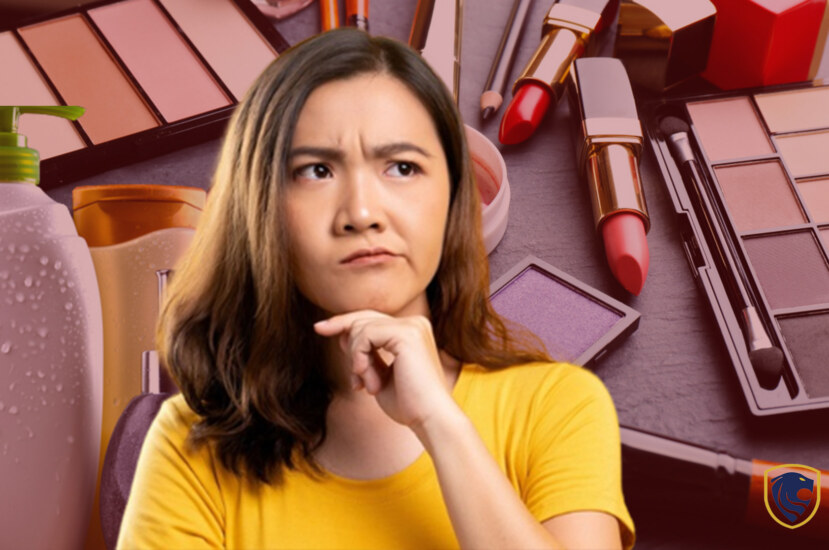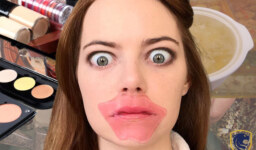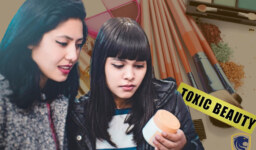Welcome to the second installment of our investigation into the hidden risks lurking behind your favorite cosmetics. In this chapter, we continue to investigate possible dangers related with popular cosmetics and skincare chemicals. These hidden dangers can have a negative impact on your health and well-being, ranging from skin irritations to hormone abnormalities. By throwing light on these problems, we hope to equip you with the knowledge you need to make educated decisions about your beauty regimen. Whether you want to avoid particular chemicals or seek into safer alternatives, this trip will provide you with the knowledge you need to prioritize your health and attractiveness at the same time.
Triclosan
Triclosan, a chemical included in many cosmetic and personal care products, may bring hidden hazards. It is frequently used as an antimicrobial agent in products such as antibacterial soaps and toothpaste.
Triclosan has the potential to alter hormones in the body, notably thyroid hormone. This disturbance can disrupt the endocrine system and cause hormonal imbalances, potentially leading to health problems. Furthermore, triclosan may lead to antibiotic resistance, which is becoming a rising worldwide health problem. Because of its broad usage in personal care products, bacteria may become less susceptible to medicines, making illnesses more difficult to cure.

Triclosan
The environmental impact of triclosan is also a source of concern. It is difficult to degrade and can collect in water sources, potentially endangering aquatic life. Some nations and manufacturers have limited or prohibited the use of triclosan in personal care products in response to these concerns. However, it’s still vital to read product labels and avoid triclosan-containing products. Especially if you’re concerned about its possible health dangers or environmental effect.
You can help safeguard both your health and the environment by being aware of the potential hidden hazards linked with triclosan and making educated decisions when purchasing beauty and personal care products.
Oxybenzone
Oxybenzone is a common ingredient present in various sunscreens, and it has certain unintended consequences that you should be aware of. Its major role is to absorb UV rays and protect the skin from harm caused by the sun. However, because of its ability to alter hormones in the body, oxybenzone has aroused concerns. It has the ability to imitate the hormone estrogen, creating hormonal imbalances and possibly harmful health repercussions. Oxybenzone has also been associated to skin allergies and sensitivities, producing skin symptoms such as redness and itching in some people.

Oxybenzone
There are also questions regarding its environmental impact. When oxybenzone is dumped into oceans and other bodies of water, it can destroy coral reefs and aquatic ecosystems. To safeguard marine life, certain places have prohibited or limited the use of oxybenzone-containing sunscreens.
Consider utilising sunscreen products labelled “oxybenzone-free” or “reef-friendly” to limit your exposure to oxybenzone’s hidden risks. These options employ various UV filters that are less hazardous to both your health and the environment.
You can protect your skin and help to preserve our precious aquatic ecosystems by being aware of the possible effects of oxybenzone and making informed decisions when purchasing sunscreen products. Your beauty should always priorities your health and the welfare of our world.
Toluene
Toluene is a chemical included in several beauty products that masks possible risks you should be aware of. It’s typically included in nail polishes and hair colors to provide a smooth application and long-lasting color. Toluene’s ability to impact the neurological system is one cause for concern. Prolonged exposure to high quantities of toluene, which is common in industrial settings, can cause headaches, dizziness, and even more serious neurological disorders. Furthermore, breathing toluene vapors, which can occur while applying nail cosmetics, might be dangerous. It can cause respiratory difficulties as well as eye, nose, and throat discomfort.

Toluene
Toluene can potentially be dangerous during pregnancy. High amounts of exposure may damage fetal development, hence pregnant women should limit their interaction with toluene-containing items. Some people are more sensitive to toluene and may develop skin responses while using toluene-containing nail paints or hair colors.
To decrease the potential hidden hazards of toluene, look for cosmetic products that are labelled “toluene-free” or “non-toxic.” These products employ different substances that do not pose the same hazards. You may safeguard your health and well-being by being aware of the possible risks of toluene and making educated decisions when purchasing beauty and nail products. Your beauty regimen should boost your confidence rather than jeopardies your health, and limiting your exposure to toluene is essential.
PEG Compounds
PEG compounds are widely utilized in cosmetics and skincare products due to their flexibility as emollients, emulsifiers, and penetration enhancers. However, PEG compounds have possible hidden risks underlying their ubiquitous use. One source of worry is that PEG compounds may be contaminated with carcinogens such as ethylene oxide and 1,4-dioxane. While not all PEG compounds are polluted, it is difficult for consumers to assess the purity of the items they use. PEG compounds can potentially cause skin irritation, particularly in those with sensitive skin. This might cause redness, irritation, or rashes.

PEG Compounds
Furthermore, because PEG compounds can promote the absorption of other chemicals into the skin, certain persons may be more sensitive to them. This increased absorption might result in increased skin responses. To avoid any hidden hazards connected with PEG chemicals, look for items labelled “PEG-free” or “non-comedogenic.” These products employ different substances that do not pose the same hazards.
Being aware of the possible dangers of PEG compounds and making informed decisions when purchasing beauty and skincare products can help safeguard your skin and general health. Your beauty regimen should boost your self-esteem and comfort, and limiting your exposure to potentially dangerous components is one step towards a safer, healthier approach to skincare and cosmetics.
Coal tar dyes
Coal tar dyes, also known as synthetic dyes, are widely used in the beauty industry to add vibrant colors to cosmetics, hair dyes, and even nail polishes. However, hidden dangers lurk within these eye-catching hues. One concern is the potential carcinogenicity of coal tar dyes. Some of these dyes are derived from coal tar, a byproduct of coal processing. Some studies have linked exposure to coal tar and coal tar dyes to an increased risk of cancer. Moreover, coal tar dyes can cause skin sensitivities and allergies in some individuals. Skin reactions like itching, redness, and rashes can occur after using products containing these dyes.

Coal tar dyes
In addition to skin concerns, coal tar dyes can lead to eye and respiratory irritations when used in eye cosmetics and hair dyes. To mitigate potential hidden dangers, consider opting for beauty products labeled as “coal tar dye-free” or “natural colorants.” These products use alternative color sources that are less likely to pose health risks. Being aware of the potential hazards of coal tar dyes and making informed choices when selecting beauty and cosmetic products can help protect your skin and overall health. Your beauty routine should boost your confidence, not jeopardize your well-being, and opting for safer colorants is a step toward a healthier approach to skincare and cosmetics.
Retinyl Palmitate
Retinyl Palmitate is a popular chemical in many beauty products, especially skincare. It is a kind of vitamin A that is frequently advocated for its possible advantages in decreasing indications of ageing and enhancing skin texture. However, there are some risks linked with Retinyl Palmitate that should be avoided. One issue is that it may enhance skin sensitivity to the sun. This can increase the skin’s susceptibility to UV exposure, potentially leading to sunburn and skin ageing. As a result, it is critical to take sun protection when utilizing Retinyl Palmitate-containing products. Furthermore, Retinyl Palmitate can cause skin irritation, redness, and peeling, especially in people who have sensitive or dry skin. It may not be suited for everyone, and patch testing should be performed before using goods containing this component.

Retinyl Palmitate
Another consideration is its usage during pregnancy. High dosages of vitamin A, particularly Retinyl Palmitate, can be hazardous to fetal development. Also, pregnant women should be cautious and contact with healthcare specialists. Read product labels carefully and be aware of the content of Retinyl Palmitate in skincare products to prevent any hidden hazards. Choosing products with lesser concentrations or alternative components may be a safer option, particularly for those with sensitive skin or pregnant women. Being aware of the possible hazards of Retinyl Palmitate and making informed decisions in your beauty regimen will help you obtain the desired skincare outcomes while minimizing the hidden problems it may provide. Making safer choices in your beauty regimen will help you improve both your look and your well-being.
Lead
Lead is a heavy metal, and its presence in cosmetics can offer concealed health risks. It is critical to be aware of these possible hazards. One source of worry is lead’s ability to accumulate in the body over time, even in trace levels. Long-term lead exposure can cause major health concerns, including neurological and developmental disorders. Some lip cosmetics contain lead, particularly older formulas and some lipsticks. The issue at hand is accidental ingestion. When lipstick is applied, some of it may be mistakenly eaten, possibly exposing the user to lead. Although there are legal limitations for lead in cosmetics, it is crucial to recognize that even low quantities of lead can be dangerous, especially to pregnant women and young children.

Lead
Lead exposure can also have a negative impact on the environment when these goods are washed away and end up in water sources. To protect yourself from the hidden hazards of lead, look for cosmetic products labelled “lead-free” or “tested for heavy metals.” It is also critical to remain up to date on product recalls and ingredient safety. Your health and well-being should always come first, and being aware of the presence of lead in beauty products is an important step towards a safer beauty regimen.
Ethanolamine (MEA, DEA, TEA)
Mono ethanolamine (MEA), Diethanolamine (DEA), and Triethanolamine (TEA) are ethanolamines that are commonly found in cosmetics and personal care products. These substances include hidden hazards that you should be aware of. One source of worry is that they may cause skin and eye discomfort. Ethanolamines can deplete the skin’s natural oils, causing dryness and redness. When using products containing these chemicals, some people may feel burning or stinging sensations. Furthermore, when ethanolamines react with other compounds, they can produce nitrosamines, which are recognized carcinogens. Nitrosamines are carcinogenic and can be absorbed via the skin. Environmentally, ethanolamines are also a source of worry. They can affect aquatic life and ecosystems when washed off and introduced into water sources.

Ethanolamine (MEA, DEA, TEA)
To avoid any hidden hazards, look for cosmetic products labelled “ethanolamine-free” or “MEA/DEA/TEA-free.” These products include chemicals that are less likely to cause skin irritation or the formation of nitrosamines.
Knowing the risks of ethanolamines and making educated decisions when purchasing cosmetics and personal care items may help safeguard your skin and general health. Your beauty regimen should improve both your look and your overall well-being, and limiting your exposure to potentially dangerous components is a step towards a safer and healthier approach to skincare and cosmetics.




